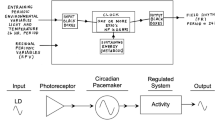Abstract
Autonomous circadian clocks drive daily rhythms in physiology and behaviour. A network of coupled neurons, the suprachiasmatic nucleus (SCN), serves as a robust self-sustained circadian pacemaker. Synchronization of this timer to the environmental light-dark cycle is crucial for an organism’s fitness. In a recent theoretical and experimental study it was shown that coupling governs the entrainment range of circadian clocks. We apply the theory of coupled oscillators to analyse how diffusive and mean-field coupling affects the entrainment range of interacting cells. Mean-field coupling leads to amplitude expansion of weak oscillators and, as a result, reduces the entrainment range. We also show that coupling determines the rigidity of the synchronized SCN network, i.e. the relaxation rates upon perturbation. Our simulations and analytical calculations using generic oscillator models help to elucidate how coupling determines the entrainment of the SCN. Our theoretical framework helps to interpret experimental data.
Similar content being viewed by others
References
T. Roenneberg, S. Daan, M. Merrow, J. Biol. Rhythms 18, 183 (2003)
C. Huygens, Horologium oscillatorium, English translation: The pendulum clock (Iowa State University Press, Ames, 1986, 1673)
Y. Kuramoto, Chemical oscillations, waves, and turbulence (Courier Dover Publications, 2003)
V.S. Anishchenko, V. Astakhov, A. Neiman, T. Vadivasova, L. Schimansky-Geier, Nonlinear Dynamics of Chaotic and Stochastic Systems: Tutorial and Modern Developments (Springer-Verlag, New York, LLC, 2007)
A. Balanov, N. Janson, D. Postnov, O. Sosnovtseva, Synchronization: From Simple to Complex (Springer-Verlag, New York, 2009)
H. Ukai, H.R. Ueda, Ann. Rev. Physiol. 72, 579 (2010)
D.K. Welsh, D.E. Logothetis, M. Meister, S.M. Reppert, Neuron 14, 697 (1995)
E.D. Herzog, S.J. Aton, R. Numano, Y. Sakaki, H. Tei, J. Biol. Rhythms 19, 35 (2004)
A.C. Liu et al., Cell 129, 605 (2007)
S.J. Aton, E.D. Herzog, Neuron 48, 531 (2005)
D.K. Welsh, J.S. Takahashi, S.A. Kay, Ann. Rev. Physiol. 72, 551 (2010)
M. Comas, D.G.M. Beersma, K. Spoelstra, S. Daan, J. Biol. Rhythms 21, 362 (2006)
H.D. Piggins, M.C. Antle, B. Rusak, J. Neurosci. 15, 5612 (1995)
C. Pittendrigh, S. Daan, J. Comp. Physiol. A 106, 291 (1976)
J. Aschoff, H. Pohl, Naturwissenschaften 65, 80 (1978)
J. Vilaplana, T. Cambras, A. Campuzano, A. Díez-Noguera, Chronobiol. Int. 14, 9 (1997)
K. Yagita, H. Okamura, FEBS Lett. 465, 79 (2000)
E.D. Buhr, S.H. Yoo, J.S. Takahashi, Science 330, 379 (2010)
U. Abraham, A.E. Granada, P.O. Westermark, M. Heine, A. Kramer, H. Herzel, Mol. Syst. Biol. 6, 438 (2010)
A. Winfree, The geometry of biological time (Springer-Verlag, New York, 1980)
R.E. Kronauer, C.A. Czeisler, S.F. Pilato, M.C. Moore-Ede, E.D. Weitzman, Am. J. Physiol. 242, R3 (1982)
L. Glass, M.M. Mackey, From Clocks to Chaos: The Rhythms of Life (Princeton University Press, 1988)
J.C. Leloup, A. Goldbeter, Proc. Natl. Acad. Sci. U.S.A. 100, 7051 (2003)
D.B. Forger, C.S. Peskin, Proc. Natl. Acad. Sci. U.S.A. 100, 14806 (2003)
S. Becker-Weimann, J. Wolf, H. Herzel, A. Kramer, Biophys. J. 87, 3023 (2004)
A.E. Granada, H. Herzel, PLoS One 4, e7057 (2009)
S. Yamaguchi, H. Isejima, T. Matsuo, R. Okura, K. Yagita, M. Kobayashi, H. Okamura, Science 302, 1408 (2003)
P.O. Westermark, D.K. Welsh, H. Okamura, H. Herzel, PLoS Comput. Biol. 5, e1000580 (2009)
C.S. Pittendrigh, W.T. Kyner, T. Takamura, J. Biol. Rhythms 6, 299 (1991)
M.H. Vitaterna, C.H. Ko, A.M. Chang, E.D. Buhr, E.M. Fruechte, A. Schook, M.P. Antoch, F.W. Turek, J.S. Takahashi, Proc. Natl. Acad. Sci. U.S.A. 103, 9327 (2006)
S.A. Brown, D. Kunz, A. Dumas, P.O. Westermark, K. Vanselow, A. Tilmann-Wahnschaffe, H. Herzel, A. Kramer, Proc. Natl. Acad. Sci. U.S.A. 105, 1602 (2008)
H.T. van der Leest, J.H.T. Rohling, S. Michel, J.H. Meijer, PLoS One 4, e4976 (2009)
W. Ebeling, H. Herzel, W. Richert, L. Schimansky-Geier, Z. Angew. Math. Mech. 66, 141 (1986)
R. Wever, J. Theor. Biol. 36, 119 (1972)
M.D. Schwartz, C. Wotus, T. Liu, W.O. Friesen, J. Borjigin, G.A. Oda, H.O. de la Iglesia, Proc. Natl. Acad. Sci. U.S.A. 106, 17540 (2009)
A.E. Granada, T. Cambras, A. Díez-Noguera, H. Herzel, Interface Focus 1, 153 (2011)
K. Bar-Eli, J. Phys. Chem. 88, 3616 (1984)
D. Aronson, G. Ermentrout, N. Kopell, Physica D 41, 403 (1990)
G. Asher, U. Schibler, Cell Metabol. 13, 125 (2011)
J.S. O’Neill, E.S. Maywood, J.E. Chesham, J.S. Takahashi, M.H. Hastings, Science 320, 949 (2008)
A. Granada, R.M. Hennig, B. Ronacher, A. Kramer, H. Herzel, Methods Enzymol. 454, 1 (2009)
A. Pikovsky, O. Popovych, Y. Maistrenko, Phys. Rev. Lett. 87, 044102 (2001)
E. Doedel, R. Paffenroth, A. Champneys, T. Fairgrieve, Y. Kuznetsov, B. Oldeman, B. Sandstede, X. Wang, AUTO2000: Continuation and bifurcation software for ordinary differential equations (with HOMCONT), Technical report, Concordia University, 2002
Author information
Authors and Affiliations
Corresponding author
Rights and permissions
About this article
Cite this article
Bordyugov, G., Granada, A.E. & Herzel, H. How coupling determines the entrainment of circadian clocks. Eur. Phys. J. B 82, 227–234 (2011). https://doi.org/10.1140/epjb/e2011-20337-1
Received:
Revised:
Published:
Issue Date:
DOI: https://doi.org/10.1140/epjb/e2011-20337-1




